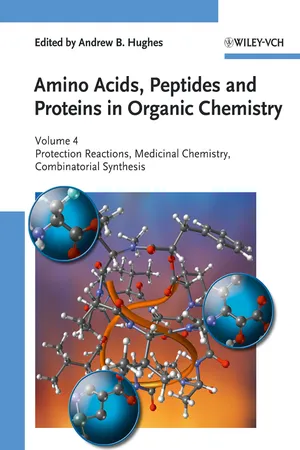![]()
Chapter 1
Protection Reactions
Vommina V. Sureshbabu and Narasimhamurthy Narendra
1.1 General Considerations
Peptides, polypeptides, and proteins are the universal constituents of the biosphere. They are responsible for the structural and functional integrity of cells. They form the chemical basis of cellular functions that are based on highly specific molecular recognition and binding, and are involved as key participants in cellular processes. A peptide or a protein is a copolymer of α-amino acids that are covalently linked through a secondary amide bond (called a peptide bond). They differ from one another by the number and sequence of the constituent amino acids. Generally, a molecule comprised of few amino acids is called an oligopeptide and that with many amino acids is a polypeptide (molecular weight below 10 000). Proteins contain a large number of amino acids. Due to the vitality of their role for the function as well as survival of cells, peptides and proteins are continuously synthesized. Biosynthesis of proteins is genetically controlled. A protein molecule is synthesized by stepwise linking of unprotected amino acids through the cellular machinery comprised of enzymes and nucleic acids, and functioning based on precise molecular interactions and thermodynamic control. Thousands of proteins/peptides are assembled through the combination of only 20 amino acids (referred to as coded or proteinogenic amino acids). Post-translational modifications (after assembly on ribosomes) such as attachment of nonpeptide fragments, functionalization of amino acid side-chains and the peptide backbone, and cyclization reactions confer further structural diversity on peptides.
The production of peptides via isolation from biological sources or recombinant DNA technology is associated with certain limitations per se. A minor variation in the sequence of a therapeutically active peptide isolated from a microbial or animal source relative to that of the human homolog is sufficient to cause hypersensitivity in some recipients. Further, the active drug component is often not a native peptide but a synthetic analog, which may have been reduced in size or may contain additional functional groups and non-native linkages. The development of a drug from a lead peptide involves the synthesis (both by conventional and combinatorial methods) and screening of a large number of analogs. Consequently, the major proportion of the demand for peptides is still met by chemical synthesis. Chemical synthesis is also crucial for synthesizing peptides with unnatural amino acids as well as peptide mimics, which by virtue of the presence of non-native linkages are inaccessible through ribosomal synthesis.
Synthetic peptides have to be chemically as well as optically homogenous to be able to exhibit the expected biological activity. This is typically addressed by using reactions that furnish high yields, give no or minimum side-products, and do not cause stereomutation. In addition, the peptide of interest has to be scrupulously purified after synthesis to achieve the expected level of homogeneity. The general approach to synthesize a peptide is stepwise linking of amino acids until the desired sequence is reached. However, the actual synthesis is not as simple as the approach appears to be due to the multifunctional nature of the amino acids. Typically, a proteinogenic amino acid (except Gly) contains a chiral carbon atom to which is attached the amino (α-amino), carboxy, and alkyl group (referred to as the side-chain). Gly lacks the alkyl substitution at the α-carbon atom. Also, the side-chains of many of the amino acids are functionalized.
A straightforward approach to prepare a dipeptide A–B would be to couple the carboxy-activated amino acid A with another amino acid B. However, this reaction will yield not only the expected dipeptide A–B, but also an A–A (through self-acylation) due to the competing amino group of A. The so-formed dipeptides can further react with A since they bear free amino groups and form oligopeptides A–A–B, A–A–A, or A–A–A–A, and the reaction proceeds uncontrollably to generate a mixture of self-condensation products (homopolymers) and oligopeptides of the type AnB. The process becomes even more complicated when reactive functional groups are present in the side-chains of the reacting amino acid(s). The uncontrolled reactivity of multiple groups leads to the formation of a complex mixture from which it becomes a Sisyphean task to isolate the desired product, which would have been formed, mostly, in low yield. The solution to carry out peptide synthesis in a chemoselective way is to mask the reactivity of the groups on amino acids that will not be the components of the peptide bond prior to peptide coupling step. This is done by converting the intervening functional group into an unreactive (or less reactive) form by attaching to it a new segment, referred to as a protecting group (or protection or protective function). The chemical reactions used for this purpose are known as protection reactions. The protecting groups are solely of synthetic interest and are removed whenever the functional group has to be regenerated. In other words, the protection is reversible. In the light of the concept of protection, the steps involved in the synthesis of the above dipeptide A–B are depicted in Figure 1.1.
Protections are employed for α-amino, carboxy, and side-chain functional groups (Figure 1.2). Since peptide synthesis is a multistep and repetitive process, the longevity of different protecting groups on the peptide under synthesis varies. In the present and widely followed approach of assembling peptides, wherein the peptide chain extension is from the carboxy- to amino-terminus (C → N direction), the α-amino protection is removed after each peptide coupling step to obtain a free amino group for subsequent acylation and, hence, this protection is temporary. The carboxy and side-chain protections are generally retained until the entire sequence is assembled, and are removed simultaneously in a single step at the end of the synthesis. Hence, they can be regarded as semipermanent groups. The transient α-amino ...

